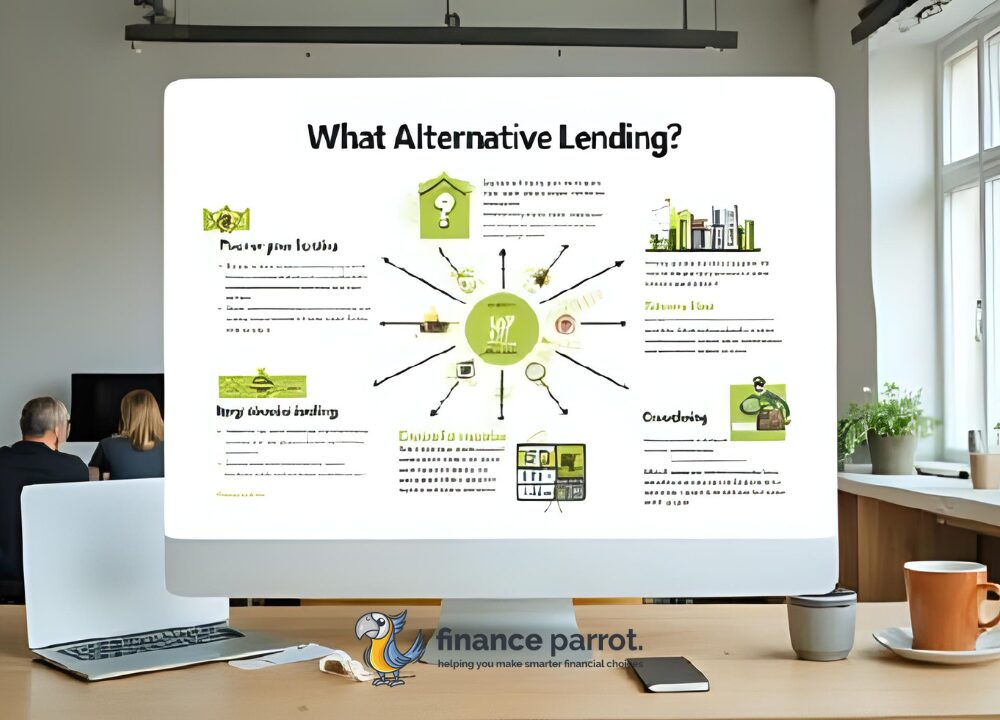Alternative Lending: Best Companies & How It Works for Small Businesses
When traditional bank loans aren’t an option, Finance Parrot explores the many alternative ways your business can access funding—fast and with fewer hurdles.
Alternative lending has become a go-to funding option for small businesses that struggle to get approved for traditional bank loans. With faster application processes, flexible requirements, and a variety of loan types, this form of financing is reshaping how entrepreneurs access capital.
In this guide, we’ll break down what alternative lending is, how it works, the pros and cons, and which companies stand out in 2025.
What Is Alternative Financing for Small Businesses?
Alternative lending refers to any type of loan or financing provided by nonbank lenders. These lenders typically operate online and include fintech companies, private lenders, or nonprofit community lenders. Unlike traditional banks, alternative lenders use digital tools and streamlined processes to approve loans quickly, sometimes in as little as 24 hours.
This type of financing is especially useful for startups, businesses with bad credit, or owners who need quick working capital.
How Alternative Small-Business Loans Work
Instead of requiring years of financial records or in-person meetings, alternative lenders often assess your creditworthiness using real-time data like:
-
Business bank statements
-
Accounting software
-
Payment processors
-
Cash flow history
Popular types of alternative business loans include:
-
Term Loans: Lump sum loans with fixed repayments
-
Lines of Credit: Flexible, revolving access to capital
-
Invoice Factoring: Selling unpaid invoices to get cash fast
-
Merchant Cash Advances (MCAs): Funding based on future sales
-
Equipment Financing: Loans specifically for purchasing equipment
While approvals are fast, interest rates can be higher than bank loans, and repayment terms may be shorter.
Key Differences: Traditional vs. Alternative Lending
| Feature | Traditional Lending | Alternative Lending |
|---|---|---|
| Application Process | In-person, paperwork-heavy | Online, fast, minimal documents |
| Approval Speed | Days to weeks | Same-day to 72 hours |
| Interest Rates | Low (6%–12%) | Higher (14%–99%) |
| Loan Amounts | Typically larger | Typically smaller |
| Requirements | Strong credit, years in business | Flexible credit, newer businesses |
Alternative lending is all about speed and flexibility. If you’re in a cash crunch or just starting out, this could be the funding lifeline you need.
Best Alternative Lending Companies in 2025
Top Providers of Alternative Financing for Small Businesses
1. Fora Financial
Best for: Large loan amounts
-
Loans from $5,000 to $1.5M
-
Terms up to 18 months
-
Decisions in under 4 hours
2. Rapid Finance
Best for: Business owners with bad credit
-
Term loans up to $1M
-
650+ credit score accepted
-
Requires 36 months in business
3. Bluevine
Best for: Fast access to working capital
-
Lines of credit up to $250,000
-
Approval in minutes
-
Funding within 24 hours
4. OnDeck
Best for: Flexible loan options
-
Short-term loans and lines of credit
-
Up to $250,000 for term loans
-
Approval in as little as 24 hours
5. iBusiness Funding
Best for: Well-established businesses
-
Up to $500,000 loans
-
Terms up to 84 months
-
Requires 660+ credit score and 2+ years in business
6. Fundbox
Best for: Startups
-
Only 3 months in business required
-
Credit score requirement: 600+
-
Credit lines up to $250,000
7. Accion Opportunity Fund
Best for: Minority- or women-owned businesses
-
Loans up to $250,000
-
Minimum 600 credit score
-
Community-focused, mission-driven lending
Best Practices for Alternative Financing for Small Businesses
Although alternative lending is accessible, it’s crucial to borrow wisely:
-
Plan ahead: Don’t wait until cash flow is critical to seek funding.
-
Read the fine print: Understand the APR, fees, and repayment schedule.
-
Compare lenders: Don’t settle for the first offer. Use platforms like Fundera to compare.
-
Use government resources: State agencies and CDFIs can help verify lender legitimacy.
Is Alternative Financing for Small Businesses Right for You?
Alternative lending can be a smart option for:
-
Startups without a long credit history
-
Businesses with bad credit
-
Entrepreneurs needing funding in under a week
However, if your business qualifies for SBA loans or bank financing, those options often come with better terms. Evaluate your needs, timeline, and repayment ability carefully.
Alternative lending continues to fill a critical gap in the small business finance world. From flexible requirements to fast funding, it’s helping business owners across the country secure capital when traditional banks say no.
Whether you’re launching a startup, expanding inventory, or managing cash flow, alternative lenders may offer the perfect solution—just make sure to choose wisely.


